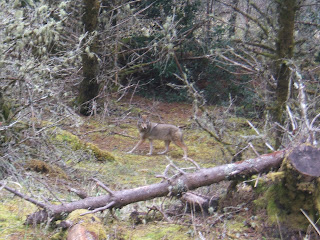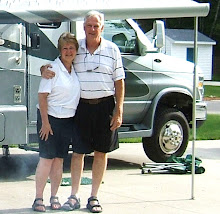












We are camped in Long Beach, Washington only a short drive from Astoria, Oregon. It's partly sunny and much better than yesterday so we snuck back over the Astoria Bridge into Oregon before the "rain gods" knew we were back! Clinging to a steep shoreline where the Columbia River meets the Pacific Ocean this town was once the roughest, toughest town between San Francisco and Seattle. It is steeped in maritime legends as well as thoseof explorers, fur traders and lumberjacks. After reading up on the history we were excited to go exploring...
Having a full day planned our first stop was the Columbia River Maritime Museum. We spent several hours here learning about the rich maritme legacy that came alive as we roamed through the extensive collections of nautical artifacts. The most dramatic exhibit was the US Coast Guard 44 foot lifeboat which shows a life size sea rescue. We learned about the Columbia River Bar Pilots, a group of 15, who guide the vessels from 100-foot tugs to 1100-foot tankers through the 17 mile danger zone. This is no place for the timid! The pilot is brought to a ship by "pilot boat" and boards the ship assuming the navigational responsibility. The pilot safely navigates the vessel to or from the entrance of the mighty Columbia River, one of the most dangerous and challenging river bars in the world. With this information under our belts we experienced a trecherous crossing through the museums newest exhibit: Crossing the Bar - Perilous Passage. This film was awesome! (we took pictures, but little blurry due to the movement...) We finished the indoor exhibits and went outside to board the Lightship Columbia. Lightships are small towns anchored about 5 miles offshore, marking the entrance to the Columbia River. It remains anchored in one place and is designed to give major navigational aid when required. They are used where construction of a lighthouse doesn't make sense. From 1892 until 1979, a lightship marked the entrance to the Columbia. During fierce winter storms, thirty-foot waves aren't unusual as they guide vessels across one of the world's most hazardous bars, known as the "Graveyard of the Pacific ".
Leaving the museum we walked the River Walk for a while enjoying the views and then went back to the car. Unfortunately the Riverfront Trolley doesn't start until May.
Our next destination was The Astoria Column. Astoria is often called "little San Francisco on a hill" due to its beautiful Victorian architecture. We drove straight up Coxcomb Hill through the narrow streets to The Astoria Column, which provides panoramic views of the city of Astoria, Oregon and Washington mountain ranges, Pacific Ocean, and the river. We walked the grounds and were able to look down into the shipping lanes below. The column is a fantastic one-of-a-kind structure built in 1926. There are fourteen 25-foot-long scenes portraying Pacific Northwest history from before the white man to 1893 when the railroad arrived. The column is an Italian art form which combines both carving and painting.
We left Astoria and traveled east on Old Hwy 101 across Youngs Bay and the Lewis and Clark River to Fort Clatsop. The Chinook and Clatsop Indians made this their home for thousands of years. This is where the Lewis and Clark Expedition spent the winter of 1805-1806 at the end of their 4000 mile trek. As we have travelled on our journey we have been in and out of the many Lewis and Clark National and State Parks and they are fantastic. They provide all types of recreation and learning opportunities. We strolled the 2 mile path along the Lewis & Clark River and enjoyed the forest and river views. It was nice to be outdoors again!
Not being finished yet we hopped back in the car and west across the penninsular to Fort Stevens State Park and the Peter Iredale shipwreck. Ft Stevens was the home of the Clatsop Indians, who lived on Point Adams which is the southern tip of land marking the entrance to the Columbia River. The park also served the U.S. military from the Civil War through World War II. The Iredale sailed from Mexico bound for Portland Oregon the crew of 27, including 2 stowaways, and 1,000 tons of ballast reached the mouth of the Columbia River in athick mist and rising tide. With stong winds from the west an attempt was made to move away from shore, but a heavy squall grounded the Peter Iredale on Clatsop Sands. It sits on the beach today as a reminder of the ocean's strength.
As we stood on a dune looking at the shipwreck we saw people driving on the beach. Of course Ken got excited. Next we are looking for the access road and off we went. The beach is hard sand and great fun. This will be the Last Hurrah for the HHR as it's days are numbered now! After playing we drove to the North Jetty at the river entrance. We meandered down the road through the forest when a coyote ran in front of us. We watched him hunt for a while and then he sauntered off. We arrived at the jetty parking area and took the trail to a wildlife bunker (for birders). We walked the beach to Adams Point. A huge ship was being escorted into the river by a US Coast Guard boat and helocopter. The helocopter was lowering me onto the ships deck. We wondered what was going on...
Now it's time to head home. As you've probably guessed this place is all about the River!
At home we relaxed and then went to bed. This was a really good day!
Pictures: (left to right) USCG Life Saving Exhibit, Pilot Boat on the bar (2-from film), Ship crossing the bar (from film), Capt Ken on the bridge, Astoria Bridge from Coxcomb Hill, Astoria Column, Ft Clatsop, Peter Iredale Wreck, HHR driving the beach, Coyote in Ft Stevens Park, Walking Adams Point, Tanker with USCG escort - spot under helocopter is a person...)

No comments:
Post a Comment